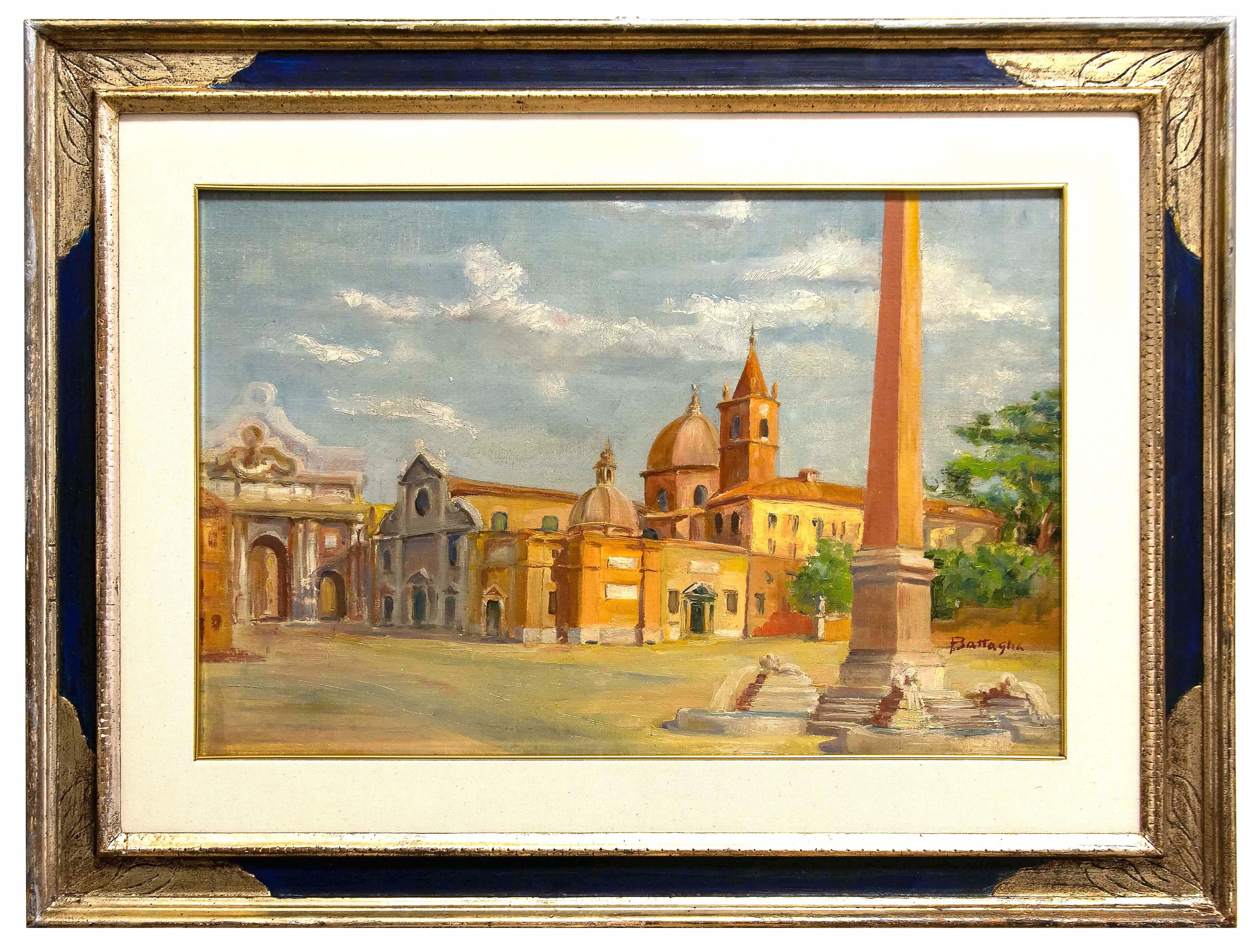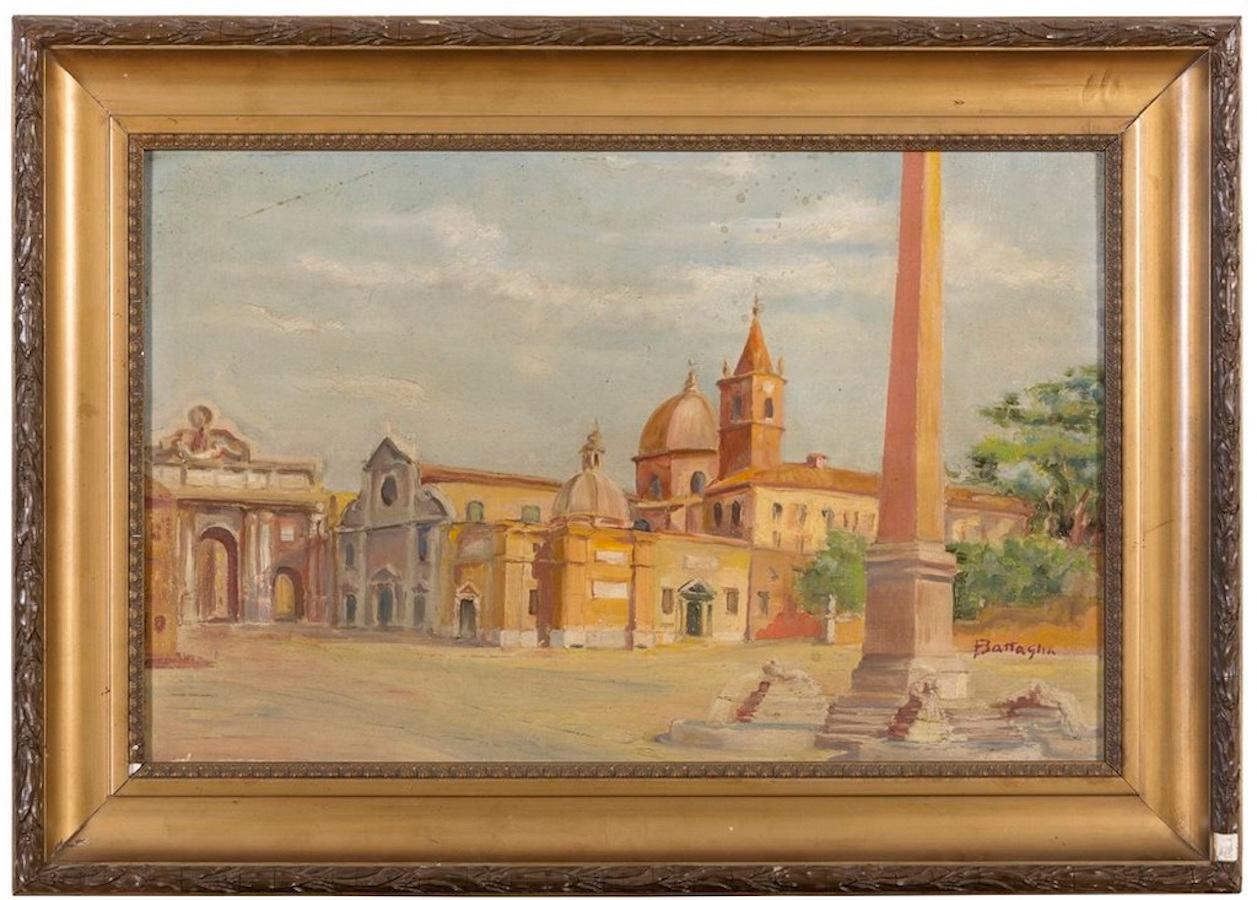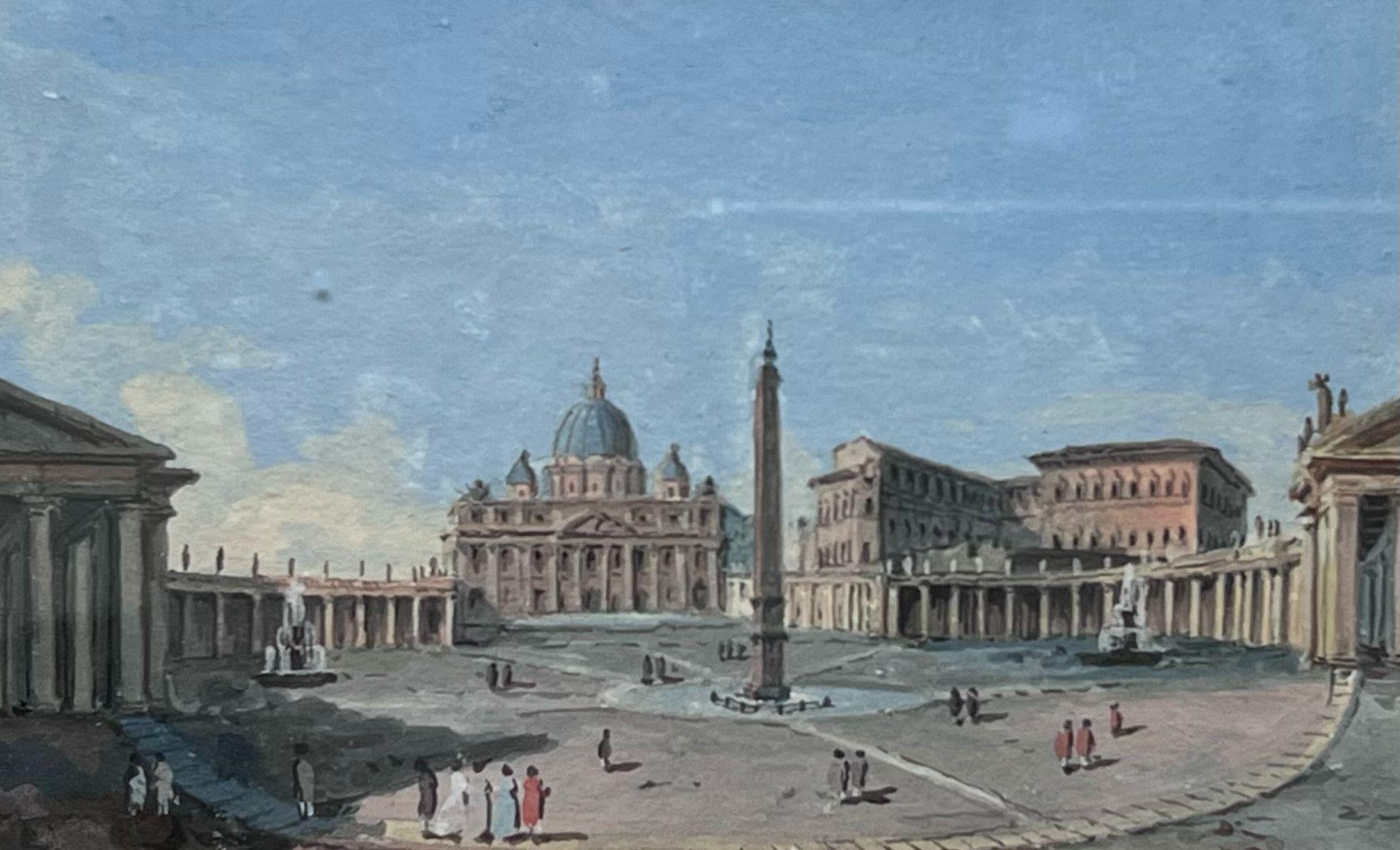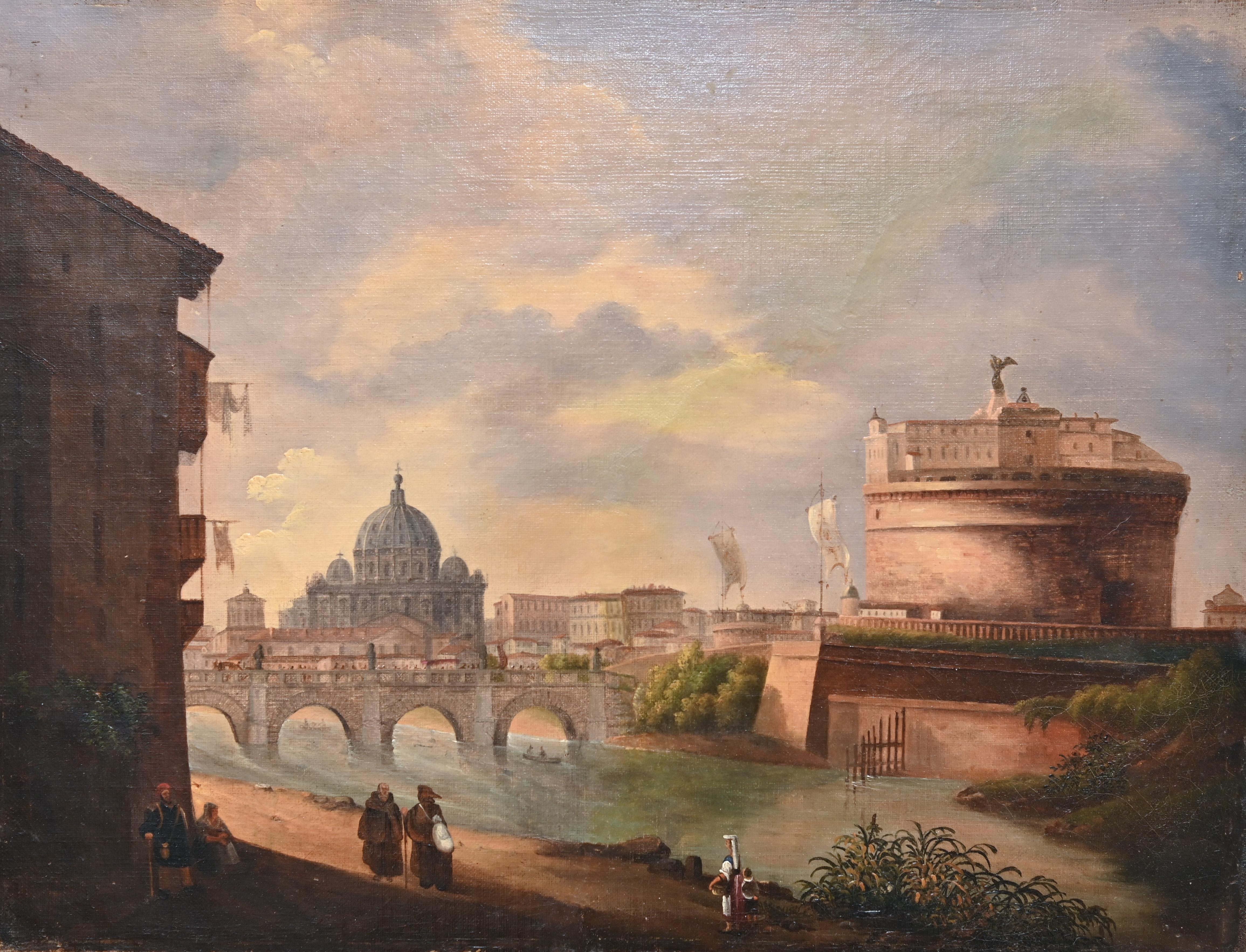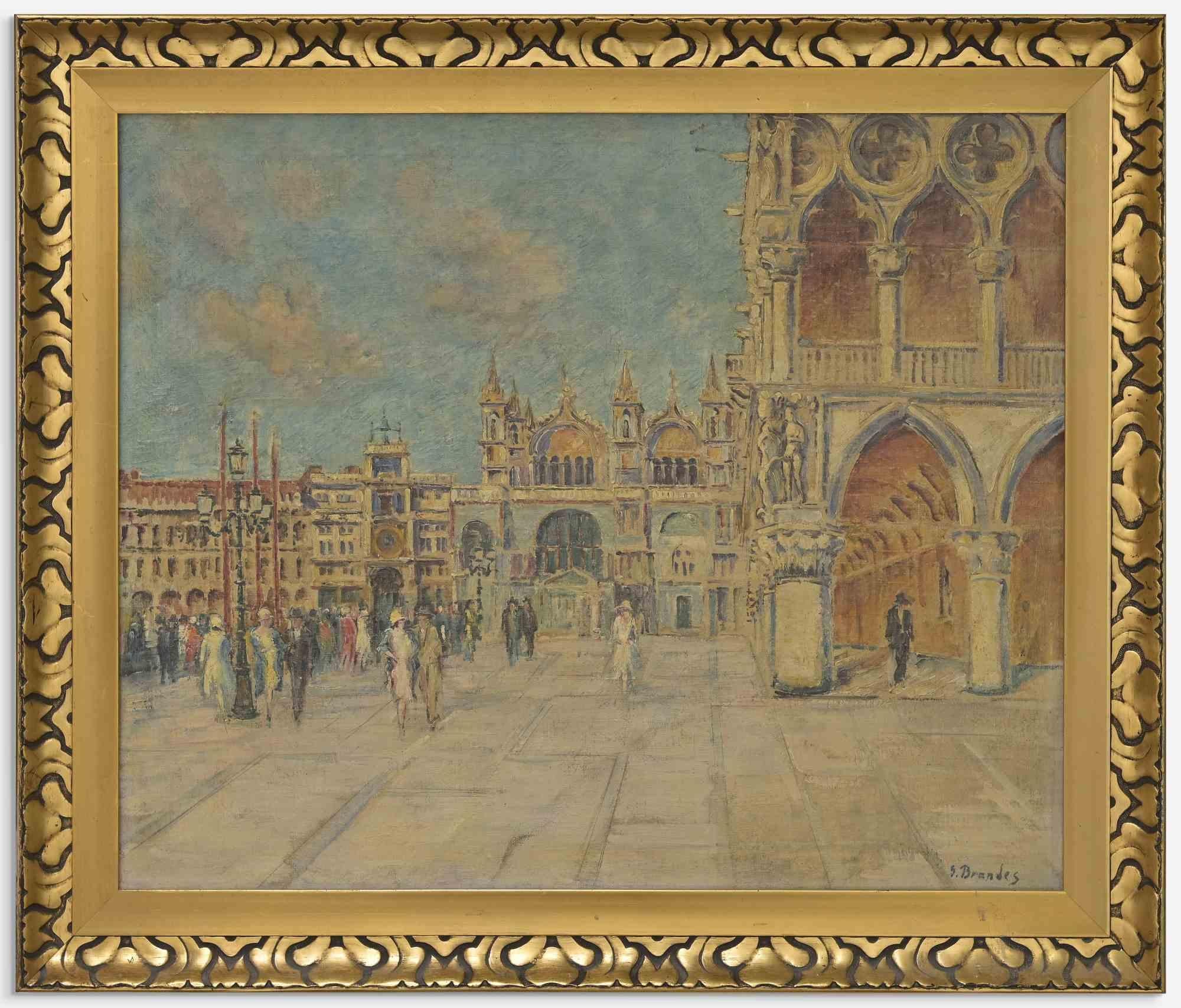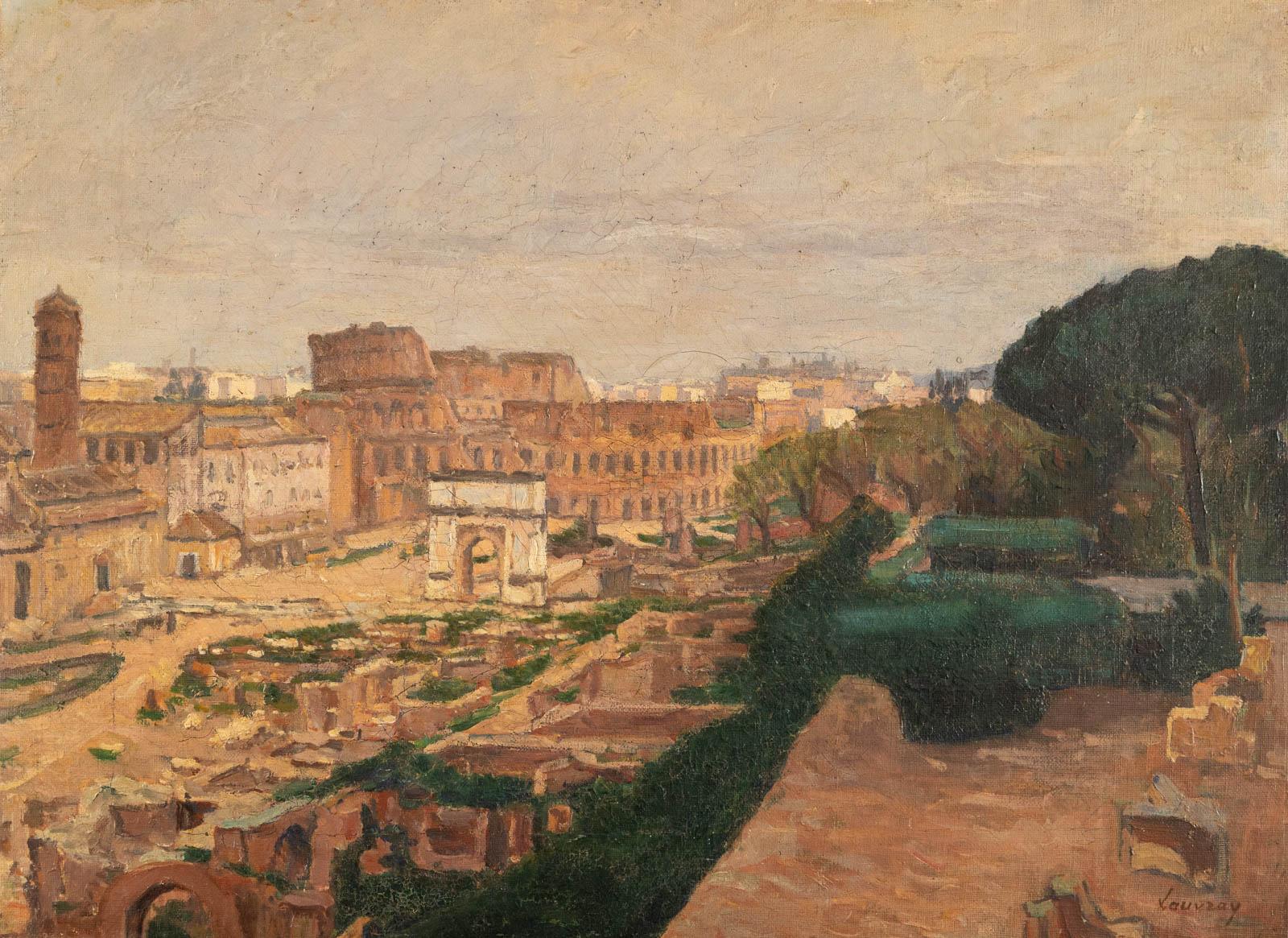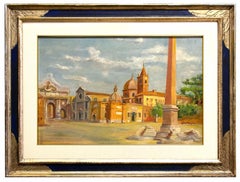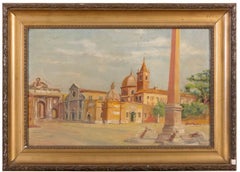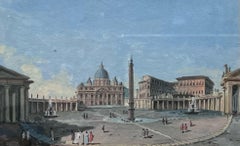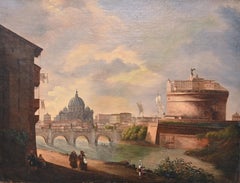Items Similar to "Saint Peter's Square, Rome", 19th Century Oil on Canvas by Gustavo Bacarisas
Want more images or videos?
Request additional images or videos from the seller
1 of 13
Gustavo Bacarisas"Saint Peter's Square, Rome", 19th Century Oil on Canvas by Gustavo Bacarisas1908
1908
$19,029.94
£14,172.89
€16,000
CA$26,690.44
A$29,276.84
CHF 15,096.96
MX$349,682.75
NOK 191,475.45
SEK 179,625.69
DKK 121,959.08
About the Item
GUSTAVO BACARISAS
Gibraltian, 1873 - 1971
SAINT PETER´S SQUARE, ROME
signed "G. BACARISAS. ROMA : 08" (lower left)
oil on canvas
19-1/4 x 27-1/4 inches (48.5 x 69 cm.)
framed: 22-3/4 x 30-3/4 inches (57.5 x 78 cm.)
PROVENANCE
Private Collector, Madrid
Gustavo Bacarisas (Gibraltar, September 23, 1873-Seville, January 7, 1971) 1 2 was a figurative style painter from Gibraltar. He studied fine arts in Rome and was a teacher for two years at the School of Fine Arts in Buenos Aires. He settled in the Spanish city of Seville in 1913. He was president of the Fine Arts Section of the Ateneo de Sevilla.
He was the son of the painter Gabriel Bacarisas and Adela Podestá. The surname Bacarisas comes from the inhabitants of the Spanish island of Menorca, Balearic Islands, who moved to Gibraltar in the 18th century. His full name was Gustavo Charles Bacarisas Podestá. He had two younger brothers: Horacio and Alberto. The Catholic congregation of the Irish Christian Brothers6 had been in Gibraltar in the first half of the 19th century. A second mission of the Christian Brothers was installed in Gibraltar in 1878. Gustavo attended this school, where he received Catholic training. This school was when he began to show interest in painting and to make his first paintings.
In 1892 he received a scholarship made by a group of British citizens, led by sponsor John Imossi. At that time it was customary for city councils and county councils to give scholarships for artists to study abroad. Baccarisas went to the Escuela Libre de la Academy of Fine Arts of Rome He met in the same city with Eduardo Chicharro y Aguera, Manuel Benedito y Vives and Fernando Álvarez de Sotomayor, who were studying at the Academy of Spain in Rome.
During his stay in Italy he also visited Venice and Cadore, which are in some of his landscapes. From 1906 he frequently visited Paris and London.He left Italy in 1908. In Paris he met the studio of James McNeill Whistler, an American who frequently traveled to Paris and London. In London, the Art Society invited him to the annual salon of the Royal Academy, where he exhibited the painting Algeciras. His work was also inspired by the work of Joseph Mallord William Turner. Later, he visited Tangier. The British gallery Philipon invited him to Buenos Aires, which he visited in 1910. In Buenos Aires he met the architect Martín Noel, of whom he made a portrait, he got acquainted with Argentine painters and held an exhibition with paintings made in Tangier and with peasant scenes from the Pampas. He was appointed professor at the Academy of Fine Arts in Buenos Aires in 1911. Later, he traveled throughout the United States and held exhibitions in New York, Pittsburg, and Philadelphia.
In 1913 he settled in Seville to paint in that city. That year the Government, by Royal Decree, had commissioned Seville to commemorate the IV Centenary of the Discovery of the Pacific Ocean. At that time, the city was in the preparations for the Ibero-American Exhibition Bacarisas painted the landscapes of the city and the towns of his province. He also painted ceramics for shop signs and the decoration of the Royal pavilion and the Argentine pavilion of the exhibition.
He made the poster for the Seville Spring Festival in 1917. Later, he began to collaborate with the Ateneo de Sevilla. In 1918 he helped, from the Fine Arts Section, in the realization of the first Three Kings parade, which was the initiative of José María Izquierdo.16 In 1918 he made a trip to Granada, in which he painted several pictures. In 1919 the City Council named him Adoptive Son of Seville.
In June 1921 he participated in an exhibition at the National Library and Museums palace in Madrid. He participated with 44 canvases (most of which had been painted in Granada), 10 drawings, 2 sculptures, 3 ceramic mural projects, and eleven ceramic vessels.
In these years he also portrayed the landscapes of Alcalá de Guadaíra. This town in the province was regularly portrayed in the 19th and early 20th centuries by various painters, known as the Alcalá de Guadaíra School.
In 1922 he traveled to Sweden to make the sets and design the costumes for the opera Carmen, at the Royal Theater in Stockholm. For the costumes, he designed costumes that were faithfully reproduced by the theater's tailor shop. Swedish painter Elsa Jernas, whom he married in 1924. In 1924 he was hired by the theater director Charles Cocharan to make the sets for the opera Coppelia, which premiered at the Trocadero in London that year.
The summers of 1927 and 1928 were spent in Tosa, in the province of Gerona, and paid a visit to Cuenca in 1929. In Seville he participated in the Spring Fine Arts Exhibition in 1930 with seven paintings. In the following years he would visit Cuenca and Tosa again, as well as the Castilian-Leon towns of Segovia and Ávila and the Huelva towns of Aracena and Alájar.
In 1936 he was living in Madrid. At the start of the Civil War, he was evacuated to France and later moved to Gibraltar, and in 1938 he traveled to the Moroccan cities of Tangier and Casablanca. In 1940 he moved to the Portuguese island of Madeira, where he stayed for five years.
He returned to Seville in 1945. He returned to join the Fine Arts Section of the city's athenaeum. In 1947, two exhibitions dedicated to the work of Gustavo Bacarisas were held in the city. In one of them, Joaquín Romero Murube read a text dedicated to praising the work of this painter.In 1950 he was appointed Foreign Correspondent Academician of the Royal Academy of Fine Arts of Saint Elizabeth of Hungary, which presented him with the Gold Medal of the institution during a contest in the autumn.
He was named Favorite Son of Gibraltar in 1961. That year he paid a visit to Estepona, where he made several paintings.
In 1961 he was appointed honorary professor at the Santa Isabel de Hungary Superior School of Fine Arts and corresponding academic at the San Fernando Royal Academy of Fine Arts in Madrid.In 1966 he received the Gold Medal from the Seville Athenaeum.
He was a multifaceted artist, known mainly for his painting, but who also cultivated sculpture in which his bronzes Tanagra andaluza and Cabeza de joven gitana stand out; tilework; ceramic ornamentation and scenography His style contributed a modern concept to Andalusian painting, in a decorative key but capturing the spirit of things in beautiful sequences of life and the landscape of Seville and Granada. His work, in a figurative style and with a varied theme, is characterized by a rich chromaticism. As a decorator, the scenography and costumes for the opera Carmen and El amor brujo for its premiere at the Spanish theater in Madrid stand out in his production.
He made several works of tiles and ceramics. Most of his tile work was the baseboards of the Royal pavilion at the 1929 Ibero-American Exposition.
He made several posters. In 1917 he made a sketch for the poster for the April Fair. That same year he made the poster for the Spring Festivities, in 1928 he made a poster for the Ibero-American Exposition in Seville, and in 1946 he made a poster for the April Fair.
He made 114 landscape paintings. In them he portrays places in Rome, Venice, the Alps and other parts of northern Italy. Around 1911 he made a painting with a landscape of the Argentine Pampas. In the first half of the 20th century he made paintings with landscapes of the Spanish towns he visited, such as Granada, Segovia, Arcos de la Frontera (painted regularly), Cuenca, Tosa, Aroche and Madrid. Living a good part of his life in Seville, he made numerous paintings in the city, some of which were also local landscapes. He painted four pictures of Gibraltar. His landscapes had a rural or urban theme. In the 1940s he painted pictures of Madeira. He made fourteen paintings on sailor themes. He made 48 portraits, among which there were three self-portraits; 1935, 1939 and 1955.
One of his most outstanding paintings is Seville at parties, which was presented at the Seville Fine Arts Exhibition in 1916 and is currently kept in the Museum of Fine Arts in Seville. An airy, dynamic, balanced composition, extraordinarily rich in plastic strength and representative.31
Also in the Museo Carmen Thyssen Málaga is the Feria, another painting with a similar theme, but with a post-impressionist invoice, with a loose and energetic brushstroke, and a composition based on color.
Among his disciples we can mention the Sevillian painter Juan Miguel Sánchez.
- Creator:Gustavo Bacarisas (1873 - 1971)
- Creation Year:1908
- Dimensions:Height: 19.1 in (48.5 cm)Width: 27.17 in (69 cm)
- More Editions & Sizes:48.5 x 69 cm.Price: $19,030
- Medium:
- Movement & Style:
- Period:
- Condition:
- Gallery Location:Madrid, ES
- Reference Number:1stDibs: LU128118214632
About the Seller
5.0
Vetted Professional Seller
Every seller passes strict standards for authenticity and reliability
Established in 1977
1stDibs seller since 2019
21 sales on 1stDibs
Typical response time: 3 hours
- ShippingRetrieving quote...Shipping from: Madrid, Spain
- Return Policy
Authenticity Guarantee
In the unlikely event there’s an issue with an item’s authenticity, contact us within 1 year for a full refund. DetailsMoney-Back Guarantee
If your item is not as described, is damaged in transit, or does not arrive, contact us within 7 days for a full refund. Details24-Hour Cancellation
You have a 24-hour grace period in which to reconsider your purchase, with no questions asked.Vetted Professional Sellers
Our world-class sellers must adhere to strict standards for service and quality, maintaining the integrity of our listings.Price-Match Guarantee
If you find that a seller listed the same item for a lower price elsewhere, we’ll match it.Trusted Global Delivery
Our best-in-class carrier network provides specialized shipping options worldwide, including custom delivery.More From This Seller
View All"Saint Marks Square", 19th Century oil on canvas of Venice by Antonio Reyna
By Antonio Reyna Manescau
Located in Madrid, ES
ANTONIO REYNA MANESCAU
Spanish, 1859 - 1937
SAINT MARKS SQUARE
signed & located "A. Reyna, Venezia" (lower right)
oil on canvas
15-1/2 x 21-3/8 ...
Category
Early 1900s Realist Landscape Paintings
Materials
Canvas, Oil
"Place de la Concorde", 19th Century Oil on Canvas by Artist Joaquín Pallarés
Located in Madrid, ES
JOAQUÍN PALLARÉS ALLUSTANTE
Spanish, 1853 - 1935
PLACE DE LA CONCORDE
signed & located "J. PALLARÉS / París." (lower right)
oil on canvas
13-1/4 x 18-...
Category
1890s Realist Figurative Paintings
Materials
Canvas, Oil
Large "View of The Doge's Palace Venice", 19th C. Oil on Canvas by Karl Kaufmann
By Karl Kaufmann
Located in Madrid, ES
KARL KAUFMANN
Austrian, 1843 - 1901
VIEW OF VENICE OF THE DOGE'S PALACE, VENICE
signed & dated "K. Kaufmann 1894" (lower right)
oil on canvas
38-3/4 x 56-1/8 inches (98 x 142 cm.)
fr...
Category
1890s Naturalistic Figurative Paintings
Materials
Canvas, Oil
Large "View of Venice", 19th Century Oil on Canvas by Karl Kaufmann
By Karl Kaufmann
Located in Madrid, ES
KARL KAUFMANN
Austrian, 1843 - 1901
VIEW OF VENICE
signed & dated "K. Kaufmann 1894" (lower right)
oil on canvas
38-3/4 x 56-1/8 inches (98 x 142 cm.)
framed: 41-1/2 x 59-1/4 inches ...
Category
1890s Naturalistic Figurative Paintings
Materials
Canvas, Oil
"Place Clichy" 20th Century Impressionist Oil on Canvas by Eduardo León Garrido
By Eduardo Leon Garrido
Located in Madrid, ES
EDUARDO LEÓN GARRIDO
Spanish, 1856- 1949
PLACE CLICHY
signed "E. L Garrido" (lower right)
oil on canvas
24-1/8 x 19-3/4 inches (61 x 50 cm.)
framed: 33-1/4 x 28-7/8 inches (84 x 73 cm.)
PROVENANCE
Private Spanish Collector
Fresh and bright view of Clichy Square, Paris, where Leon Garrido offers us his most impressionistic and innovative technique.
The work has a pyramidal composition, from where monument to "Mariscal Moncey" on an 8 meter high pedestal and decorated with bas-reliefs that dominates the entire square.
The florist occupies a central place, from which distinguished figures appear around her. Its delicate and smooth chromaticism in gray and pearly dark almost black and a touch of red.
Eduardo León Garrido (Madrid, 1856 - Caen, 1949) was a Spanish painter. He began his training at the Higher School of Painting in Madrid and as a disciple in Vicente Palmaroli...
Category
Early 1900s Post-Impressionist Landscape Paintings
Materials
Canvas, Oil
"Venetian scene", 19th Century oil on canvas laid on cardboard by Antonio Reyna
By Antonio Reyna Manescau
Located in Madrid, ES
ANTONIO REYNA MANESCAU
Spanish, 1859 - 1937
VENETIAN SCENE
signed & located "A. Reyna, Venezia" (lower right)
oil on canvas laid on cardboard
8 ...
Category
Early 1900s Realist Landscape Paintings
Materials
Canvas, Oil, Cardboard
You May Also Like
Piazza del Popolo, Rome - Oil on Cardboard - Early 20th Century
By Alessandro Battaglia
Located in Roma, IT
Piazza del Popolo, Rome is an original painting realized in the half of XX century by Alessandro Battaglia.
Mixed colored oil painting on cardboard.
Hand signed on the lower right...
Category
Early 20th Century Modern Figurative Paintings
Materials
Oil Pastel
Piazza del Popolo, Rome - Oil on Canvased Cardboard - Early 20th Century
By Alessandro Battaglia
Located in Roma, IT
Piazza del Popolo is an original modern artwork realized by the Italian artist Alessandro Battaglia (1870-1940) in the first years of the XX century.
Original oil on canvased cardbo...
Category
Early 20th Century Figurative Paintings
Materials
Canvas, Oil, Cardboard
St. Peter's Square Vatican View Early 19th Century Grand Tour Gouache on Paper
Located in Cirencester, Gloucestershire
This captivating gouache on paper painting, dating from the early 19th century, offers a beautifully detailed view of St. Peter's Square in Vatican City, making it a likely relic of ...
Category
Early 19th Century Old Masters Landscape Paintings
Materials
Gouache
Rome with St Peter - Oil Panting by Follower of G. Van Wittel - 19th century
Located in Roma, IT
Rome with St Peter is an oil paint on canvas realized by a follower of Gaspar Van Wittel in 19th century.
The artwork depicts a view of St. Peter in Rome.
...
Category
19th Century Modern Landscape Paintings
Materials
Canvas, Oil
View of St. Mark's Square... - Oil Paint by Georg Brandes - Early 20th Century
Located in Roma, IT
View of St. Mark's Square and Doge's Palace in Venice is an artwork realized by Georg Brandes (1878 - 1952).
Oil Painting, Early 20th Century.
56x68 c...
Category
Early 20th Century Modern Landscape Paintings
Materials
Oil
Rome, l'Arc De Titus
Located in LE HAVRE, FR
Abel LAUVRAY (1870-1950)
Rome, the Arch of Titus
Oil on cardboard mounted on canvas
Size: 48 x 65 cm
Signed lower right
Painting in good condition.
A few fine cracks without liftin...
Category
Early 20th Century Impressionist Landscape Paintings
Materials
Canvas, Oil, Cardboard
